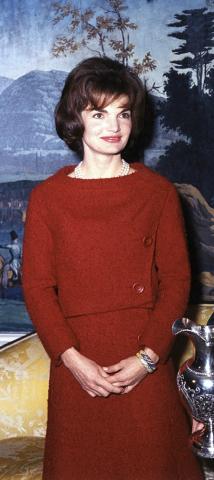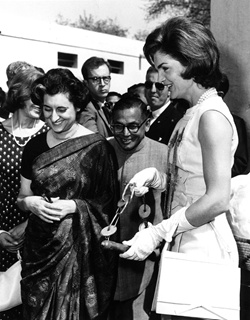Jacqueline Bouvier Kennedy played a historic role during the Kennedy administration—in restoring the White House, supporting the arts, promoting historic preservation, and serving as a traveling ambassador.
In January 1960, Senator John F. Kennedy of Massachusetts announced his candidacy for the presidency of the United States, launching 11 months of cross-country campaigning. A few weeks into the campaign, Jacqueline Kennedy became pregnant with their second child, and her doctors instructed her to remain at home. There she answered campaign mail, taped TV commercials, gave interviews and wrote "Campaign Wife," a syndicated column carried across the nation.
Celebration of a Kennedy election victory was followed just weeks later by celebration of the birth of John Fitzgerald Kennedy, Jr. At age 31, Jacqueline Kennedy became the third youngest first lady in US history and the first to be the mother of an infant since the turn of the century. Though she defined her major roles as 'to take care of the president' and raise her children, she would go on to make her own lasting marks as first lady.
In the White House
Jacqueline Kennedy had first visited the White House as a tourist with her mother and sister in 1941. She was dismayed to see so few historical furnishings on display and frustrated by the lack of a booklet to inform visitors about the history of the great house. Twenty years later, as first lady, she sought to change things and make the White House "the most perfect house in the United States."
Before her husband's inauguration, Mrs. Kennedy visited the White House as the guest of First Lady Mamie Eisenhower. Disappointed with its appearance, Mrs. Kennedy referred to the White House as "that dreary Maison Blanche." Calling it an "18th-century house," she believed that it should be furnished with antiques in the style of past presidents. It was, she thought, a museum that should reflect the artistic history of the United States.
Restoration, Not Decoration
"All these people come to see the White House and they see practically nothing that dates back before 1948," Mrs. Kennedy said in a September 1, 1961 interview with Hugh Sidey of Life magazine. "Everything in the White House must have a reason for being there. It would be sacrilege merely to "redecorate" it -- a word I hate. It must be restored -- and that has nothing to do with decoration. That is a question of scholarship."
Mrs. Kennedy's passion for history guided and informed her work in the White House. She wanted to share her knowledge and excitement about the past with all Americans, especially children. She understood that to a child, American history can often be a dry and dull affair, and she saw a visit to the President's House as a chance to spark each child's interest in the people who made the country what it is today.
An Historic Hunt
Mrs. Kennedy quickly learned that many White House furnishings of the past were kept in government storage facilities throughout Washington, DC. Presidential families had kept some pieces when they left the White House; others had been sold at public auctions in the 19th century.
Her goal was to restore the state rooms of the White House to reflect the artistic and architectural history of the presidential mansion. Within a month of becoming first lady, she established a White House Fine Arts Committee made up of experts in historic preservation and decorative arts.
Mrs. Kennedy and her committee located many pieces of furniture and artwork that had been owned by presidents, had been part of the White House collection, or exemplified the period portrayed in the different rooms. They also persuaded many owners of historic furnishings to donate them to the White House.
Most important among their finds were items that had belonged to Presidents Washington, Lincoln, and Madison. Mrs. Kennedy personally went through each White House storage room unearthing forgotten pieces. She then had them restored and returned to places of prominence.
She began with the restoration of the Oval Office. Among the pieces of furniture she found in the White House was a desk made from the timbers of the British sailing ship HMS Resolute, presented by Queen Victoria in 1878 to President Rutherford B. Hayes. Mrs. Kennedy had it dusted off and moved into the Oval Office where it remains today. An exact replica of the desk can be found in the Kennedy Library and Museum's Oval Office exhibit.
The White House Historical Association
To avoid the politically controversial use of public money for this work, Mrs. Kennedy established the White House Historical Association, which would publish the first official White House guidebook in 1962. All profits from the sale of the guidebook to the millions who toured the White House would be used to fund the restoration project and to purchase the furnishings and other historic materials located by the Fine Arts Committee.
Together with the newly appointed White House curator, she approved the guidebook's text, chose which photographs would be featured, and designed the layout. Within ten months of publication, 500,000 copies were sold. The White House: An Historic Guide continues to support the work of the White House Historical Association.
The White House on TV
With her project near completion, Mrs. Kennedy agreed to conduct a televised tour of the Executive Mansion for CBS Television on February 14, 1962. A record audience of 56 million viewers tuned in to hear the first lady as she guided them through the White House and its newly restored rooms. The White House, she said, was not only a place for the president to work and live, but also as a destination for every American who visited Washington, DC, a showcase for art and culture, and a place of national pride.
The tour was so well received that the Academy of Television Arts and Sciences awarded Mrs. Kennedy an honorary Emmy Award for her achievement.
Historic Preservation
Mrs. Kennedy's interests in historic preservation went beyond the White House walls. She asked her friend, Rachel "Bunny" Mellon, to redesign the president's Rose Garden. She envisioned the garden as a natural sanctuary and retreat just outside the Oval Office and an ideal space for greeting special visitors and large groups.
In 1962, Mrs. Kennedy learned that the historic homes that lined Lafayette Square across the street from the White House were scheduled for demolition to make room for large government office buildings. She personally intervened and commissioned a new plan that preserved the historical identity of the famous square. The period town homes were sheathed in red brick and the new office buildings placed behind them.
Mrs. Kennedy also advocated the restoration of Pennsylvania Avenue, the main thoroughfare that connected the White House to Capitol Hill, and supported creation of a national cultural complex, which eventually became the Kennedy Center for the Performing Arts in Washington, DC.
Her interest in preservation extended beyond the United States and included her involvement in the rescue of the ancient Egyptian temples at Abu Simbel, which were threatened by the floodwaters created by the Aswan Dam. Her enthusiasm for historical preservation contributed to its growing influence throughout the nation and enhanced Americans' understanding and appreciation of their heritage.
A Champion of the Arts
Mrs. Kennedy was also a patriot. Like President Kennedy, she believed that American civilization had come of age. Together they celebrated American arts and letters and encouraged Americans to take pride in their artistic, as well as their political, heritage. They used diplomatic occasions at home and abroad to express core national values; to celebrate American history, culture, and achievement; and to enhance the role of the arts in national life.
As first lady, Jacqueline Kennedy planned elegant state occasions, transforming the White House into a showcase for cultural and intellectual achievement. Authors, scientists, artists, musicians and actors mingled with politicians, diplomats, and statesmen. In the East Room, she had a portable stage built for musical and dramatic performances, including a series of concerts for young people. Through these activities and others, Mrs. Kennedy encouraged a new public regard for the arts. In the world of fashion, Mrs. Kennedy became a trendsetter. Her taste influenced designers, magazines, newspapers, and the public.
Traveling Ambassador
Mrs. Kennedy's interest in the cultures of other countries and her fluency in languages made her a popular ambassador around the world. She accompanied her husband on trips to France, Austria, the United Kingdom, Venezuela, Mexico, Costa Rica, and Columbia and also traveled as first lady to Italy, Pakistan, and India.
Mrs. Kennedy spoke French fluently. The extraordinarily warm reception she received on a visit to Paris in May 1961 prompted President Kennedy to remark, "I do not think it altogether inappropriate to introduce myself... I am the man who accompanied Jacqueline Kennedy to Paris, and I have enjoyed it."
After the White House
On November 22, 1963 John F. Kennedy was assassinated in Dallas and Jacqueline Kennedy became a widow at age 34. She planned the president's state funeral, which was watched by millions around the world who shared her grief and admired her courage and dignity.
Soon after President Kennedy's death, she began the work to build the John F. Kennedy Library, which would commemorate her husband's life. She chose then-unknown architect I.M. Pei to design the library and decided upon a striking location overlooking Boston Harbor.
In 1968, Jacqueline Kennedy married Greek shipping magnate Aristotle Onassis. After his death in 1975, she embarked on a successful career in publishing. On May 19, 1994, Jacqueline Bouvier Kennedy Onassis died in her New York City home. She was laid to rest beside President Kennedy in Arlington National Cemetery outside Washington, DC.



